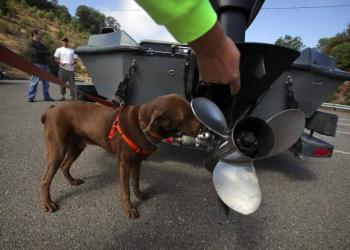
Kelly Test Requirements and Dog Scent Trailing Evidence; Foundational Requirements for Dog Scent Trailing Evidence:
(1) Dog scent trail evidence is admissible without the need to meet the foundational and reliability requirements as described in People v. Kelly (i.e., the “Kelly/Frye test”). (2) Dog scent trailing evidence is admissible so long as a proper foundation is laid concerning the dog handler’s expertise, the present ability of the dog in issue to trail a human, and some corroboration that the person being trailed had in fact been at the location in issue.
Defendant Scott Lee Peterson lived with his wife, Laci, in Modesto, California. Laci worked as a substitute teacher while defendant ran a startup fertilizer company out of a leased warehouse. After a few years in Modesto, Laci became pregnant with their first child who they named “Conner,” with a due-date in February, 2003. On the day before Christmas, 2002, neighbors found the Petersons’ dog with his leash attached wandering around the neighborhood. With neither defendant nor Laci home, the neighbors merely put the dog in the Petersons’ backyard. Defendant came home at about 4:30 p.m. that afternoon, washed his clothes, and ate some pizza. He then called Laci’s mother to see if she had seen Laci that day, referring to his wife as “missing.” With the police eventually being called, it was determined that there were no signs of forced entry at the Peterson house and Laci’s purse was still there. Defendant suggested that maybe she had been accosted while walking the dog. He also claimed that he had gone fishing that day in San Francisco Bay despite the cool, drizzly weather. Defendant, however, was immediately a suspect, giving non-committal and inconsistent answers to questions. He also showed little concern that Laci was missing. When asked, defendant claimed that there were no current problems in his marriage and denied that he was involved in any love affairs with anyone. Skipping a whole bunch of othere little pieces of evidence here and there, all indicating that defendant might have had something to do with his wife’s disappearance, the kicker came when on December 30th (six days after Laci’s disappearance), a woman named Amber Frey reported to the Modesto Police that she was in the midst of an affair with defendant, and had been since November (Can we spell, “motive?”), and that they had in fact been sexually intimate. Frey soon figured out that defendant had been telling her a whole pack of lies since they met, including that he had never been married, soon changing that story to having been married, but that he lost his wife and was facing the prospect of spending the holidays without her for the first time. Meanwhile, the Modesto Police collected articles from the Peterson home what Laci would have touched (a slipper and a pair of her sunglasses), intending to eventually use them with “trailing dogs” so that they could search for Laci’s scent. Under authority of a warrant, police placed a surveillance camera outside the Peterson home and GPS tracking devices on his vehicles, including a series of vehicles defendant rented for a few days at a time. The surveillance camera didn’t help much, but the tracking devices showed that defendant drove the approximately 90 miles from his home to the Berkeley Marina in San Francisco Bay at least five times in January, each time using a different vehicle. Defendant also started making a lot of big changes, such as terminating the lease he had for the warehouse where his business had been, making preparations to sell his house, trading in Laci’s car for a pickup truck, stopping mail delivery and opening a post office box, converting Conner’s room into a storage space, and cancelling the satellite television service to his home, explaining to them that he was moving overseas. Finally, in April, both Laci’s and Conner’s badly decomposed bodies washed ashore after a storm hit the San Francisco Bay area. Although the cause of their respective deaths could not be determined, an autopsy indicated that Laci was still pregnant with Conner when she died. Around that same time, defendant did things indicating that he was about to flee (e.g., bought a car with cash in his mother’s name while using a fake driver’s license number, growing a goatee and mustache, dying his hair, and not returning phone calls). He was therefore arrested on April 18th and booked on two counts of murder. When arrested, defendant was in possession of nearly $15,000 in cash, foreign currency, two drivers’ licenses (his own and his brother’s), a family member’s credit card, camping gear, considerable extra clothing, and multiple cell phones. At trial, the prosecution’s theory was that defendant had killed Laci sometime on the night of December 23-24. Then, on the morning of the 24th, he let their dog out with his leash on to make it appear something had happened while Laci was walking him. He took her body to the Berkeley Marina in his boat which he stored at his leased warehouse, motored out to an area near Brooks Island, and slipped her body—attached to homemade concrete weights he had fashioned as an anchor—into the bay. He then returned to Modesto, dropped the boat off at the warehouse, put gas on a tarp he kept in the boat to cover any odors left from Laci’s body, washed his clothes, and proceeded with the ruse that Laci was missing, all the while hoping her body would never be found. The jury convicted defendant of murder in the first degree for killing Laci and murder in the second degree for killing Conner. (P.C. § 189.) It also found true a multiple murder special circumstance. (P.C. § 190.2(a)(3).) Sentenced to death, his appeal to the California Supreme Court was automatic.





